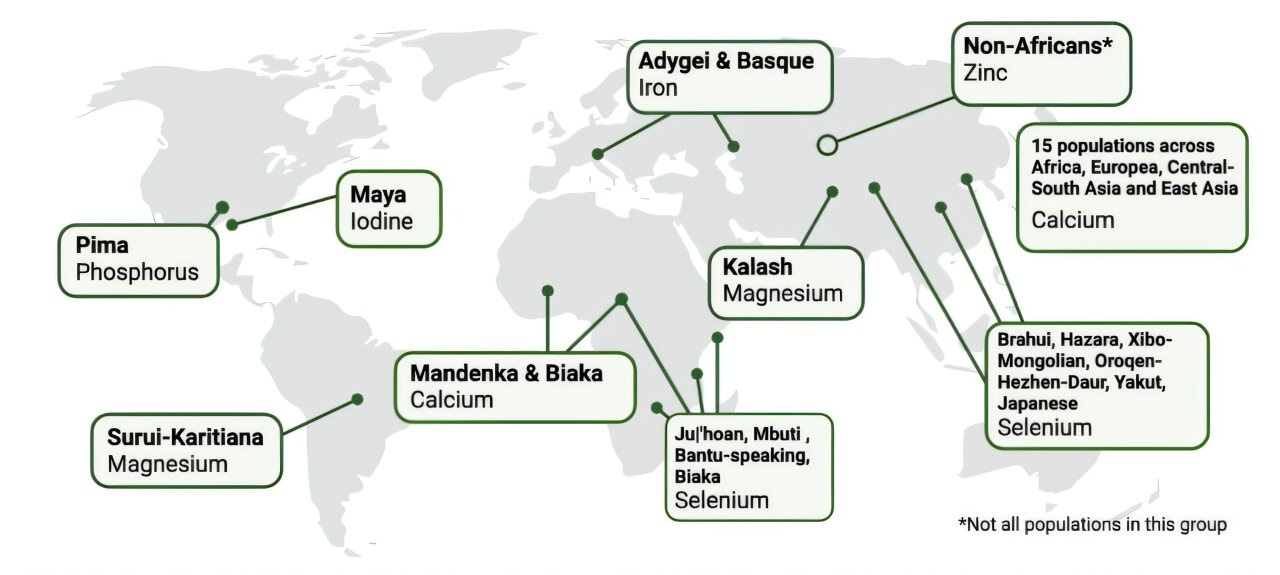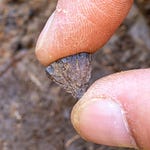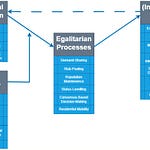A century ago, British doctors in colonial Africa were puzzled by goiter, a swelling of the neck linked to iodine deficiency, appearing in people living far from the sea. Yet this phenomenon had much deeper roots. Across thousands of years, shortages and surpluses of essential minerals such as iodine, iron, zinc, and calcium quietly sculpted the human genome. A new study in The American Journal of Human Genetics1 argues that the genetic fingerprints of these pressures are still visible today.
“Different human populations lived in different environments, so they had to adapt to different kinds of environmental pressures, such as disease and diet, that over time can drive trait differences,” said Jasmin Rees, first author of the study.
The Evolutionary Weight of Trace Elements
Micronutrients are the molecular background of life. Iron builds blood; zinc shapes immunity; calcium hardens bones; iodine fuels the thyroid. Yet their availability depends on geography. Soils vary, rivers leach or concentrate minerals, and whole ecosystems express these differences in the food they produce. Before vitamins and fortification, human populations had no buffer.
The new study took a broad look at this hidden map, asking whether the evolutionary signatures of micronutrient availability were still encoded in our DNA. Researchers examined 276 genes linked to how humans absorb, transport, or use 13 essential minerals, scanning the genomes of more than 900 people from 40 populations worldwide.
“Different human populations lived in different environments, so they had to adapt to different kinds of environmental pressures… This paper is a first step in understanding which populations might be most at risk.” — Jasmin Rees
Genes as Geological Records
For every mineral studied, at least one population carried signs of adaptation in the genes regulating its use. This was not a localized effect—it was global. Each essential mineral left its mark on at least one group of humans at some point in history.

In the Maya, whose ancestors lived in iodine-poor soils, the researchers found strong evidence of genetic changes in iodine metabolism. In parts of South Asia with unusually high magnesium levels, they identified two genes suggesting adaptation to prevent magnesium toxicity. The findings suggest that across continents and millennia, genes responded to the quiet but persistent tug of local geology.
A Mosaic of Human Diets
Before agriculture, people already depended on their environment for trace elements. But farming and settlement likely intensified the problem. Soil depletion, monoculture, and new diets amplified shortages and sometimes created surpluses. Over thousands of years, these pressures influenced which gene variants thrived.
“This paper is a first step in understanding which populations might be most at risk,” Rees said. “We hope with more studies, the findings can eventually help inform public health going forward.”
Why It Matters for the Present
Modern human populations are not starting from scratch. Each carries a legacy of past adaptations. As climate change and industrial farming continue to strip soils of nutrients, understanding these inherited vulnerabilities could help predict who is most at risk for deficiency-related disease.
Anthropologists and geneticists are now asking how deep this pattern runs. Did micronutrient pressure shape not just physical health but also cognition or reproductive patterns? Could mineral deficiencies explain aspects of migration, settlement, or even myths about sacred springs and salt? These are open questions, but the Rees team’s data lay a foundation.
Related Research
Other studies echo this focus on diet and evolution, each shows how diet-related pressures have repeatedly shaped the human genome.:
Andrés, A. M. et al. (2020). Balancing selection maintains a form of the APOL1 gene that protects against sleeping sickness but increases kidney disease risk. Nature Genetics, 52, 835–845. https://doi.org/10.1038/s41588-020-0633-8
Mathieson, I., & Mathieson, S. (2018). FADS gene adaptation to plant-based diets in Europe. Nature Ecology & Evolution, 2, 1887–1892. https://doi.org/10.1038/s41559-018-0697-8
Tishkoff, S. A., et al. (2007). Convergent adaptation of lactase persistence in Africa and Europe. Nature Genetics, 39, 31–40. https://doi.org/10.1038/ng1946
Rees, J., Castellano, S., & Andrés, A. M. (2025). Global impact of micronutrients in modern human evolution. The American Journal of Human Genetics. https://doi.org/10.1016/j.ajhg.2025.08.005









